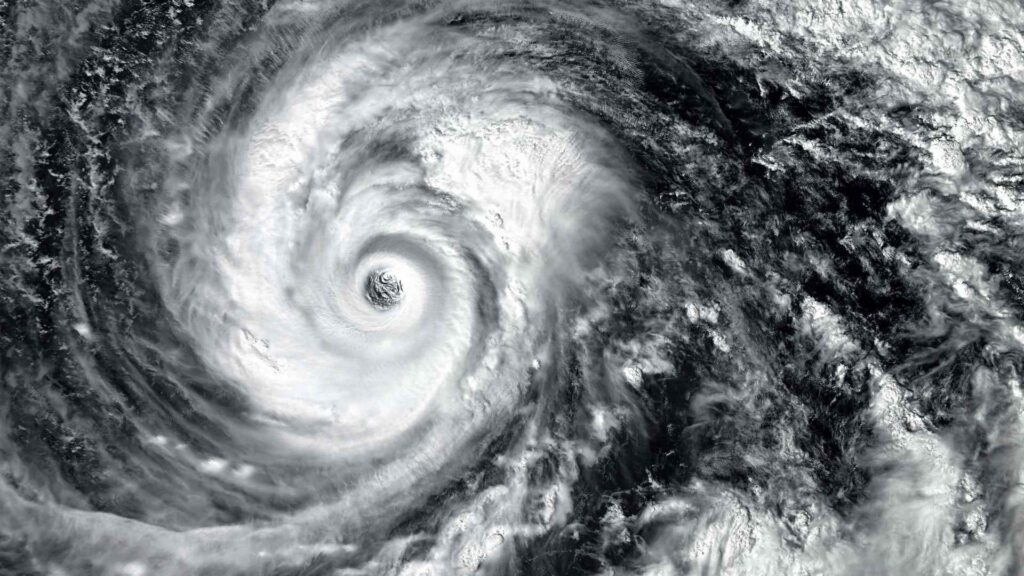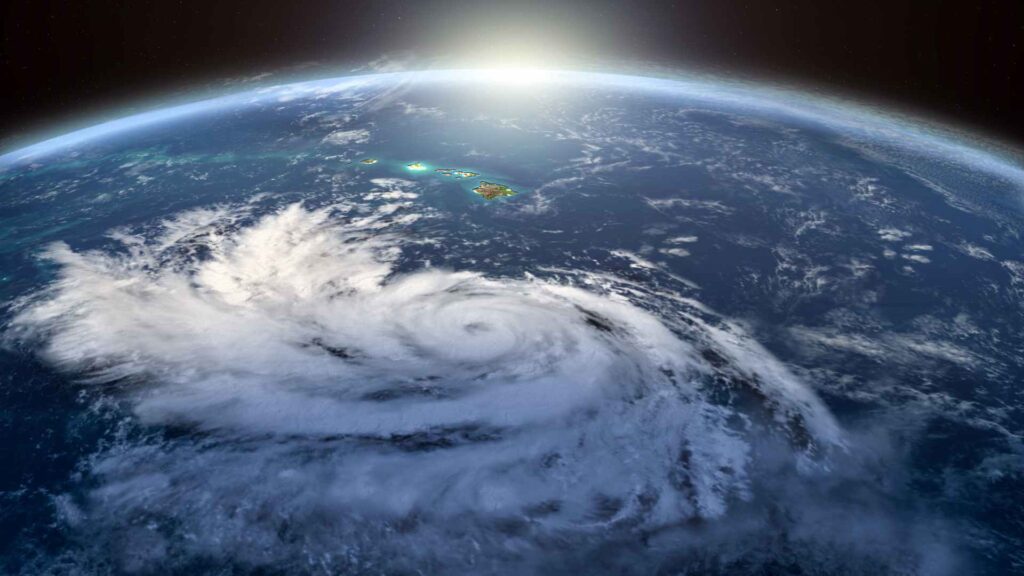Hurricanes are among nature’s most powerful and awe-inspiring phenomena.
These massive storms can reshape landscapes, impact millions, and spark endless fascination.
In this ultimate guide, you’ll explore over 145 incredible facts about hurricanes, categorized to cover everything from their formation to the legends surrounding them.
What Are Hurricanes? Essential Facts
- Hurricanes are massive tropical storms fueled by warm ocean waters.
- They are called “cyclones” in the Indian Ocean and “typhoons” in the Pacific.
- Hurricanes need water temperatures of at least 80°F to form.
- These storms have a well-defined “eye,” surrounded by the eyewall, the most intense part of the storm.
- Hurricanes are measured on the Saffir-Simpson scale, ranging from Category 1 to 5.
- The word “hurricane” originates from the Taino word “huracán,” meaning god of wind.
- On average, the Atlantic hurricane season produces 12 named storms annually.
- Hurricanes rotate counterclockwise in the Northern Hemisphere and clockwise in the Southern Hemisphere.
- The largest hurricane ever recorded was Typhoon Tip in 1979, with a diameter of 1,380 miles.
- A hurricane can release the energy of 10 atomic bombs every second.
- The eye of a hurricane can be as large as 40 miles wide.
- The term “tropical cyclone” encompasses hurricanes, typhoons, and cyclones.
- Hurricanes weaken significantly over land due to the lack of warm water.
- The “storm surge,” a rise in seawater level, causes the most hurricane-related fatalities.
- Wind speeds in a Category 5 hurricane exceed 157 mph.

How Hurricanes Form: The Science Behind the Storm
- Hurricanes form over warm ocean water near the equator.
- Rising warm, moist air creates low-pressure systems, pulling in surrounding air.
- Earth’s rotation causes the Coriolis effect, helping storms spin.
- A hurricane needs at least five to six days to fully develop.
- High-altitude winds, known as wind shear, can disrupt hurricane formation.
- The warm water acts as fuel, with higher temperatures increasing storm intensity.
- Hurricanes can’t form at the equator because the Coriolis effect is too weak there.
- During formation, a disturbance can evolve into a tropical depression, then a tropical storm, and finally a hurricane.
- Low-pressure systems allow storms to draw in more moisture and heat, intensifying the storm.
- High-pressure systems around a hurricane help steer its path.
- Hurricanes can rapidly intensify when ideal conditions align.
- Dry air and cooler waters can weaken a hurricane.
- Hurricanes lose their source of energy once they move over land or colder waters.
- The strongest hurricanes form over the Atlantic or Pacific Oceans during peak seasons.
- Atmospheric moisture from hurricanes can reach heights of 50,000 feet.

History and Record-Breaking Hurricanes
- The deadliest hurricane on record is the Great Hurricane of 1780, which killed over 22,000 people in the Caribbean.
- Hurricane Katrina (2005) caused over $161 billion in damages, making it the costliest U.S. hurricane.
- The Galveston Hurricane of 1900 remains the deadliest U.S. hurricane, killing over 6,000 people.
- Typhoon Haiyan (2013) in the Philippines had some of the highest wind speeds ever recorded at 195 mph.
- Hurricane Harvey (2017) caused unprecedented flooding in Houston, Texas, with over 60 inches of rain.
- In 1992, Hurricane Andrew devastated South Florida as a Category 5 storm.
- The Labor Day Hurricane of 1935 was the most intense U.S. hurricane, with a central pressure of 892 millibars.
- Hurricane Sandy (2012), nicknamed “Superstorm Sandy,” caused significant damage in the northeastern U.S. despite being downgraded.
- In 2020, Hurricane Iota became the strongest storm of the Atlantic season.
- The Atlantic hurricane season of 2020 was the most active, with 30 named storms.
- The longest-lasting hurricane was Hurricane/Typhoon John (1994), which lasted 31 days.
- Hurricane Irma (2017) maintained Category 5 strength for 37 hours, the longest for any storm on record.
- Cyclone Bhola (1970) in Bangladesh was one of the most devastating storms, killing over 500,000 people.
- In 2005, Hurricane Wilma had the lowest central pressure ever recorded in the Atlantic at 882 millibars.
- The first satellite image of a hurricane was captured in 1960 by TIROS-1.

Impacts of Hurricanes on Humans and the Environment
- Hurricanes displace millions of people every year.
- These storms reshape coastlines, eroding beaches and changing landscapes.
- Hurricanes can spread invasive species through storm surges.
- The cost of rebuilding after a major hurricane can exceed billions of dollars.
- Storm surges flood coastal areas, destroying habitats and infrastructure.
- Hurricanes can cause power outages for weeks or months.
- The agricultural industry often suffers from flooding and crop destruction.
- Hurricanes impact marine ecosystems, disrupting coral reefs and fish populations.
- Strong winds can topple trees, causing widespread deforestation.
- Freshwater flooding from hurricanes contaminates drinking water supplies.
- Hurricanes can trigger landslides in mountainous areas.
- Relief and recovery efforts require extensive international cooperation.
- Hurricanes create economic hardships for affected communities.
- Insurance claims spike after major hurricanes, driving up premiums.
- People often face mental health challenges after experiencing hurricanes.
Interesting Hurricane Legends and Myths
- Ancient sailors believed hurricanes were caused by angry sea gods.
- The Taino people associated hurricanes with their deity Juracán.
- Early European settlers blamed hurricanes on witchcraft.
- Some cultures believe hurricanes bring purification to the Earth.
- The Bermuda Triangle is often associated with mysterious hurricane disappearances.
- Native American tribes used stars to predict hurricane seasons.
- Superstitions suggested sacrificing animals to calm storms.
- The phrase “hurricane lamps” originated from storm preparations.
- Sailors in the 1800s carried “storm charms” for protection.
- Folklore says whistling during a storm invites hurricanes.
- Myths claim hurricanes can reveal buried treasures.
- Some believe the “calm before the storm” predicts hurricanes.
- Early maps marked hurricanes with symbols of angry faces.
- Hurricanes were often attributed to divine punishment.
- Legends suggest hurricanes clear out evil spirits.
Bonus Facts: Even More to Know About Hurricanes
- The National Hurricane Center tracks storms using satellites and airplanes.
- Naming hurricanes began in 1953 to improve public communication.
- Hurricane names are retired if a storm is particularly deadly or costly.
- Male names were added to hurricane lists in 1979.
- Hurricane forecasts are most accurate within 48 hours.
- The calm “eye” can mislead people into thinking the storm is over.
- Hurricanes can spawn tornadoes as they make landfall.
- Warm water from the Gulf Stream often intensifies Atlantic hurricanes.
- Cyclones can occur in the polar regions, though they’re weaker than tropical hurricanes.
- Hurricanes affect airline routes, causing major disruptions.
- Animals often sense hurricanes before they arrive and seek shelter.
- Hurricanes can disrupt ocean currents, impacting global climates.
- Cloud seeding experiments attempted to weaken hurricanes in the 1960s.
- “Hurricane hunters” fly directly into storms to gather data.
- Hurricanes can cause bioluminescent algae to glow in the ocean.
- The word “storm surge” was coined in the 19th century.
- Hurricanes were once thought to be caused by volcanic eruptions.
- Satellites can now detect hurricanes days before they form.
- Hurricanes can transfer heat from the equator to polar regions.
- The fastest intensification of a hurricane occurred in 2015 with Hurricane Patricia.
- Hurricanes can last for weeks, traveling thousands of miles across oceans.
- The energy released by a hurricane could power the global economy for years.
- Hurricanes often follow predictable paths, known as hurricane tracks.
- Weather balloons are launched before hurricanes to collect atmospheric data.
- In 1998, Hurricane Mitch stalled over Central America, dumping over 75 inches of rain.
- The average lifespan of a hurricane is 9 days.
- Hurricanes are one of the few natural phenomena visible from space.
- The term “eye wall replacement cycle” refers to the process of a storm reorganizing to become stronger.
- Hurricane-force winds can extend over 100 miles from the storm’s center.
- The first hurricane detected by radar occurred in 1944 near Texas.
- Modern hurricane forecasts rely on supercomputers for accuracy.
- Hurricane hunters have been flying into storms since the 1940s.
- Some hurricanes rapidly weaken, a phenomenon known as “dry air intrusion.”
- Warm water “hot spots” often become breeding grounds for hurricanes.
- The Atlantic hurricane season peaks in September, during the “Cape Verde” season.
- Hurricanes have been depicted in art and literature for centuries.
- Some hurricanes weaken and then restrengthen, a process called “regeneration.”
- The average diameter of a hurricane is about 300 miles.
- Hurricane winds can strip trees of all their leaves, creating “ghost forests.”
- Large hurricanes can produce a “brown ocean effect,” intensifying after landfall if conditions are right.
- Coastal wetlands act as natural barriers, reducing hurricane impact on land.
- Hurricanes can influence El Niño and La Niña weather patterns.
- Lightning is rare in hurricanes but can occur near the eyewall.
- Hurricanes can transport Sahara Desert dust across the Atlantic.
- Hurricane Wilma strengthened from a tropical storm to a Category 5 hurricane in just 24 hours.
- A “double eyewall” sometimes forms, with two concentric eyewalls around the storm’s center.
- The calmness of the eye contrasts with the extreme violence of the surrounding eyewall.
- Hurricanes impact global shipping routes, forcing detours for safety.
- In 1938, the “Long Island Express” hurricane caused widespread devastation in New England.
- The first color photographs of hurricanes were taken in the 1960s by NASA satellites.
Conclusion
Hurricanes are a testament to nature’s immense power and complexity.
From their formation to their impact on history and humanity, these 145 fun facts reveal why hurricanes captivate our imaginations. Stay informed, stay safe, and never stop exploring the incredible science behind these storms!
